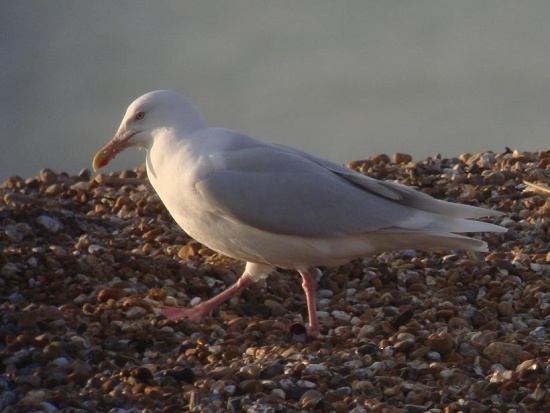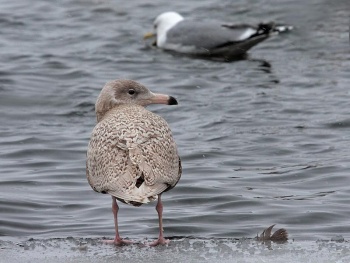(Picture exchanged for correct species) |
|||
| Line 5: | Line 5: | ||
Very light in all plumages, lacks black in the wings or tail.<br /> | Very light in all plumages, lacks black in the wings or tail.<br /> | ||
'''Adults''' are pale grey above, with a thick yellow bill<br /> | '''Adults''' are pale grey above, with a thick yellow bill<br /> | ||
| − | '''Immatures''' very pale grey with a pink and black bill. They take four years to reach maturity. | + | '''Immatures''' very pale grey with a pink and black bill. They take four years to reach maturity. Notice that the tip of the wings is the palest part of the wing in these. |
====Similar Species==== | ====Similar Species==== | ||
Has a larger and thicker bill than the [[Iceland Gull]], many are no larger than [[Herring Gull]] but generally size is in between Herring Gull and [[Great Black-backed Gull]]. | Has a larger and thicker bill than the [[Iceland Gull]], many are no larger than [[Herring Gull]] but generally size is in between Herring Gull and [[Great Black-backed Gull]]. | ||
Revision as of 23:33, 29 December 2014
- Larus hyperboreus
Identification
A large and powerful gull
Very light in all plumages, lacks black in the wings or tail.
Adults are pale grey above, with a thick yellow bill
Immatures very pale grey with a pink and black bill. They take four years to reach maturity. Notice that the tip of the wings is the palest part of the wing in these.
Similar Species
Has a larger and thicker bill than the Iceland Gull, many are no larger than Herring Gull but generally size is in between Herring Gull and Great Black-backed Gull.
Distribution
Breeds in west and north Iceland, Jan Mayen, Bear Island and Svalbard, on the north Russian coast from the Kanin Peninsula eastwards, and on Novaya Zemlya and Franz Josef Land.
In winter found around Iceland and from Lapland south to Denmark and the Netherlands, the north of Scotland and in smaller numbers on the east coast of Britain and northern France. Total British wintering population is usually above 200 birds with up to 600 present in some years. Many are regularly returning individuals with favoured wintering sites.
Vagrant to Spain and the Mediterranean and Black Seas, the Czech Republic, Hungary, the Canary Islands, Azores and Madeira.
Interbreeds extensively with Herring Gull in Iceland (also recorded in Scotland) and occasionally other species elsewhere in range. This species also breeds in Greenland, arctic Canada and Alaska, and winters further south in Canada and the northern U.S.
Taxonomy
Subspecies
There are 4 subspecies[1]:
- L. h. hyperboreus:
- Jan Mayen and Spitsbergen east to Taymyr Peninsula
- L. h. pallidissimus:
- Taymyr Peninsula east to Bering Sea and Pribilof Islands
- L. h. barrovianus:
- L. h. leuceretes:
Habitat
Breeds on islands and mainland cliffs, beside freshwater lakes and rivers and on inland crags and cliffs. Out of the breeding season mainly on coasts, often in fishing harbours and bays.
Behaviour
Breeding
They lay eggs, some time between the middle of May to mid June, depending on ice conditions.
Diet
Omnivorous like most Larus gulls. Also scavenge as well as seeking suitable small prey. They forage while swimming or walking, and may catch small birds in flight. Often seen following fishing boats.
Vocalisation
Call: a "laughing" cry like a Herring Gull
<flashmp3>Larus hyperboreus (song).mp3</flashmp3>
Listen in an external program
References
- Clements, J. F., T. S. Schulenberg, M. J. Iliff, B.L. Sullivan, C. L. Wood, and D. Roberson. 2013. The eBird/Clements checklist of birds of the world: Version 6.8., with updates to August 2013. Downloaded from http://www.birds.cornell.edu/clementschecklist/download/
- Nationmaster
- Handbook of the Birds of the World Alive (retrieved April 2014)
Recommended Citation
- BirdForum Opus contributors. (2025) Glaucous Gull. In: BirdForum, the forum for wild birds and birding. Retrieved 5 February 2025 from https://www.birdforum.net/opus/Glaucous_Gull
External Links






